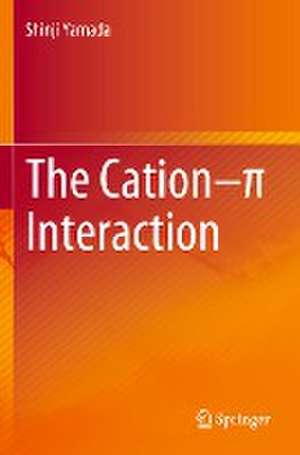The Cation–π Interaction
Autor Shinji Yamadaen Limba Engleză Paperback – 17 dec 2023
As this book covers the basic aspects of the applications of cation–π interactions it is useful for students and researchers in a wide variety of scientific fields. In addition, the book will not only facilitate understanding of the phenomena occurring in various systems but also provides insights into the design of new catalysts, reactions, and materials.
| Toate formatele și edițiile | Preț | Express |
|---|---|---|
| Paperback (1) | 994.72 lei 6-8 săpt. | |
| Springer Nature Singapore – 17 dec 2023 | 994.72 lei 6-8 săpt. | |
| Hardback (1) | 1001.81 lei 3-5 săpt. | |
| Springer Nature Singapore – 17 dec 2022 | 1001.81 lei 3-5 săpt. |
Preț: 994.72 lei
Preț vechi: 1213.07 lei
-18% Nou
Puncte Express: 1492
Preț estimativ în valută:
190.34€ • 199.23$ • 158.42£
190.34€ • 199.23$ • 158.42£
Carte tipărită la comandă
Livrare economică 31 martie-14 aprilie
Preluare comenzi: 021 569.72.76
Specificații
ISBN-13: 9789811973376
ISBN-10: 9811973377
Pagini: 194
Ilustrații: IX, 194 p. 224 illus., 165 illus. in color.
Dimensiuni: 155 x 235 mm
Greutate: 0.3 kg
Ediția:1st ed. 2022
Editura: Springer Nature Singapore
Colecția Springer
Locul publicării:Singapore, Singapore
ISBN-10: 9811973377
Pagini: 194
Ilustrații: IX, 194 p. 224 illus., 165 illus. in color.
Dimensiuni: 155 x 235 mm
Greutate: 0.3 kg
Ediția:1st ed. 2022
Editura: Springer Nature Singapore
Colecția Springer
Locul publicării:Singapore, Singapore
Cuprins
1. Introduction.- 2. Nature of Cation-pi Interaction.- 3. Structure of Cation-pi Complexes.- 4. Synthetic Application to Various Organic Reactions.- 5. Supramolecular and Biomimetic Catalysis in Organic Reactions.- 6. The role of cation-pi interactions in Biology.- 7. Application to Materials Sciences.- 8. Conclusions.
Notă biografică
Shinji Yamada received his Ph.D. degree from Hokkaido University in 1986 and was a JSPS research fellow from 1985 to 1987. From 1987 to 1990, he worked for the KAO Corporation, then in 1990 he joined the faculty of the Department of Chemistry at Kanagawa University as an assistant professor. In 1993 and 1994 he worked with Professor Charles J. Sih’s group at the University of Wisconsin (USA) as a research fellow. In 1995 he became an associate professor in the Faculty of Science at Ochanomizu University and was promoted to professor in 2003.
Dr. Yamada has published more than 100 articles including many in Chemical Reviews and has contributed to three books. His current research interests are applications of a cation–π interaction to various organic reactions and systems in both solution and solid-state.
Textul de pe ultima copertă
This book introduces the role of cation–π interactions in chemistry, biology, and polymer materials science. Since the cation–π interaction was defined in 1990, its importance has been recognized in a variety of fields due to its relatively significant interaction energy. A number of examples are introduced in which the contribution of cation-π interactions was evidenced by X-ray structures, spectroscopies, computations, and other means. The latest developments in these areas are remarkable; therefore, many recent examples are included.
As this book covers the basic aspects of the applications of cation–π interactions it is useful for students and researchers in a wide variety of scientific fields. In addition, the book will not only facilitate understanding of the phenomena occurring in various systems but also provides insights into the design of new catalysts, reactions, and materials.
Caracteristici
Introduces a wide range of recent examples of cation–π interactions in chemistry, biology, and materials science Includes only carefully selected examples containing X-ray structures, spectral evidence, or computations Uses color for clarity to show X-ray structures and computational graphics
